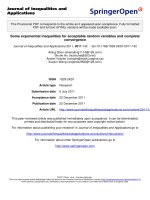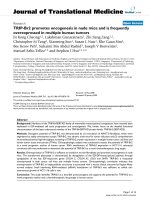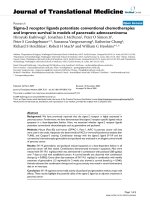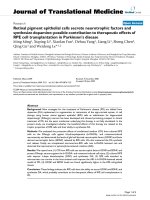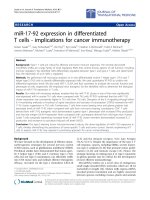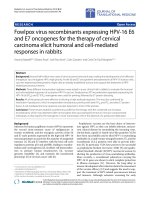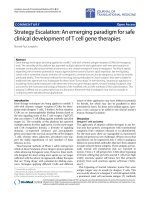Báo cáo hóa học: "DNA polymeraseh protein expression predicts treatment response and survival of metastatic gastric adenocarcinoma patients treated with oxaliplatin-based chemotherapy" pot
Bạn đang xem bản rút gọn của tài liệu. Xem và tải ngay bản đầy đủ của tài liệu tại đây (410.08 KB, 9 trang )
RESEARC H Open Access
DNA polymeraseh protein expression predicts
treatment response and survival of metastatic
gastric adenocarcinoma patients treated with
oxaliplatin-based chemotherapy
Kai-yuan Teng
1,2†
, Miao-zhen Qiu
1,2†
, Zhuang-hua Li
1,2
, Hui-yan Luo
1,2
, Zhao-lei Zeng
1
, Rong-zhen Luo
1,3
,
Hui-zhong Zhang
1,3
, Zhi-qiang Wang
1,2
, Yu-hong Li
1,2
, Rui-hua Xu
1,2*
Abstract
Background: DNA polymerase h (pol h) is capable of bypassing DNA adducts produced by cisplatin or oxaliplatin
and is associated with cellular tolerance to platinum. Previous studies showed that defective pol h resulted in
enhanced cisplatin or oxaliplatin sensitivity in some cell lines. The purpose of the present study was to investigate
the role of pol h protein expression in metastatic gastric adenocarcinoma.
Methods: Four gastric adenocarcinoma cell lines were chosen to explore the relationship between pol h protein
expression and oxaliplatin sensitivity by western blotting and MTT assay. Eighty metastatic gastric adenocarcinoma
patients treated with FOLFOX or XELOX regimen as first-line chemotherapy were analyzed, corresponding
pretreatment formalin-fixed paraffin-embedded tumor tissues were used to detect pol h pro tein expression by
immunohistochemistry. Relationship between pol h protein expression and clinical features and outcome of these
patients was analyzed.
Results: A positive linear relationship between pol h protein expression and 48 h IC50 values of oxaliplatin in four
gastric cancer cell lines was observed. Positivity of pol h protein expression was strongly associated with poor
treatment response, as well as shorter survival at both univariate (8 versus 14 months; P < 0.001) and multivariate
(hazard ratio, 4.555; 95% confidence interval, 2.461-8.429; P < 0.001) analysis in eighty metastatic gastric
adenocarcinoma patients.
Conclusions: Our study indicates that pol h is a predictive factor of treatment response and survival of metastatic
gastric adenocarcinoma patients treated with FOLFOX or XELOX as first-line chemotherapy. Therefore confirming
the value of polh in studies with prospective design is mandatory.
Background
Stomach cancer is the fourth most common cancer
worldwide, with 603,003 new cases among men and
330,290 new ca ses among wome n per year [ 1]. It is the
second most common cause of cancer related death
(700,000 deaths annually), with almost two-thirds of the
cases occurring in developing countries and 42% in
China alone [2]. Surgery remains the major potential
method to cure the disease; however, approximately 84%
of gastric cancer patients will develop to be an advanced
disease, with 30% of locally advanced cases, 30% meta-
static diseases at diagnosis, and 24% recurrence diseases
[3]. The literatures showed that the median survival was
only 3-4 months among advanced gastric cancer
patients without chemotherapy. The new generation of
chemotherapeutic agents, such as Oxaliplatin, can pro-
long survival in advanced gastric cancer to be 10 to 12
months; moreover, chemotherapy can also improve the
quality of life [4-12]. Therapeutic effect mainly depends
on the response of drugs to tumor during the first-line
* Correspondence:
† Contributed equally
1
State Key Laboratory of Oncology in South China, Guangzhou 510060,
China
Full list of author information is available at the end of the article
Teng et al. Journal of Translational Medicine 2010, 8:126
/>© 2010 Teng et al; licensee BioMed C entral Ltd. This i s an Open Access article distributed under the terms of the Creative Commons
Attribu tion License ( which permits unrestricted use, distribution, and reproduction in
any medium, provided the original work is properly cite d.
chemotherapy, because so far only one small phase III
study with 1 20 cases showed a modest survival benefit
from irinotecan monotherapy over supportive care alone
[13]. Unfortunately, due to drug resistance, only 30-50%
response rates can be achieved even though administrat-
ing new generation drugs such as docetaxel, oxaliplatin,
capecitabine, irinotecan, S1, etc to advanc ed gastric can-
cer patients as first-line treatment [3]. That means at
least 50% patients have to undergo ineffective treatment,
which may not only decrease the patients’ quality of life,
but also increase the economic burden. So how to pre-
dict response of chemotherapy agents in gastric cancer
is a very important scientific issue.
Oxaliplatin is the third generation platinum, playing a
vital role in chemotherapy for gastrointestinal cancer. Oxa-
liplatin-based combination r egimen such as oxaliplatin plus
5-FU or 5-FU-like drug has been proven to be active in
about 40-50% of advanced gastric cancer patients [14-16].
Oxaliplatin and cisplatin share the similar mechanism, and
cause mono-adducts and intra-strand or inter-strand
cross-links in the double DNA helix that severely block
DNA synthesis [17-19]. When this happens, some path-
ways of DNA damage repair may switch on, including
nucleotide excision repair (NER), mismatch repair (MR),
homologous recombination (HR), translesion DNA synth-
esis (TLS) [20]. The se adduc t repairs occur primarily
through NER [21]. TLS is another alternative way to repair
these le sions, which is mainly done by DNA polymerases h
[22]. Po lymerase h(Polh), one of lesion-replicating enzymes,
incorporates the correct nucleotide over lesions such as a
platin um adduct by TLS and continues chain elongation,
whereas classical pols cannot [23]. Polh has the highest
efficacy of bypassing Pt-GG intra-strand diadducts caused
by platinum among these lesion-replicating enzymes, with
limited fidelity [23,24]. Recent experiments have shown
that the absence of polh results in a statistically significant
enhancement in cisplatin sensitivity when comparing polh-
null Xeroderma Pigmentosum-variant human fibroblasts
with polh-expressing ones [25]. This enhancement is also
observed when the cells were treated with carboplatin and
oxal iplatin [25]. Rec ent data show that polh mRNA level
negatively correlated with cisplatin sensitivity of non small
cell lung cance r (NSCLC) c ell lines [ 26].
In the present study, we report for the first time the
relationship between polh proteinexpressionandoxali-
platin sensitivity of gastric cancer cell lines and the sig-
nificance of that in predicting treatment response and
survival of metastatic gastric cancer patients treated
with oxaliplatin-based chemotherapy.
Materials and methods
Cell lines
The gastric cancer cell lines, including SGC7901, AGS,
MKN45, and MGC803, were donated by Professor
Libing Song from State Key Laboratory of Oncology in
Southern China (Cancer Center of Sun yet-sen Univer-
sity). All cell lines were maintained in RPMI 1640
(Gibco) supplemented with 10% fetal bovine serum
(Gibco), except MKN 45 with 20% fetal bovine serum.
Patients and Samples
Patients in our clinical database with chemotherapy-
naïve, histologically proven metastatic advanced gastric
cancer were enrolled for the study. All patients had to
receive FOLFOX (fluorouracil, leucovorin and oxalipla-
tin) or XELOX (capecitabine and oxaliplatin) regimen as
first-line chemotherapy at Cancer Center of Sun Yat-sen
University, and formalin-fixed paraffin-embedded pre-
treatment samples under gastroscope biopsies or pallia-
tive operation were obtained. Histopathologic
characteristics were confirmed by blinded review of the
original pathology slides. The TNM classification was
used for pathologic staging, and the World Health Orga-
nization classification was used for pathologic grading.
Other inclusion criteria included age between 18-80,
Eastern Cooperative Oncology G roup (ECOG) perfor-
mance status of 2 or less, second line chemotherapy or
not, no radiation treatment. All patients provided writ-
ten informed consent; we obtained separate consent for
use of specimens. Study approval was obtained from
independent ethics committees at Cancer Center of Sun
Yat-Sen University. The study was undertaken in accor-
dance with the ethical standards of the World Medical
Association Declaration of Helsinki.
Follow-up and evaluations
Patients were followed up by telephone or letter com-
munication once every year for a total of 4 years. Over-
all survival was defined as the time from the date of
confirmed diagnosis to death and censored at the date
of last contact for a surviving patient. Disease response
was evaluated according to the Response Evaluation Cri-
teria in Solid Tumours (RECIST criteria) [27].
Cytotoxicity assays
Cell growth inhibition was determined by 3- (4,5-
dimethylthiazol-2-yl) -2,5-diphenyltetrazolium b romide
assay (MTT assay). Briefly, cells were seeded in 96-well
plates and allowed to attach overnight. After 48 hours
of drug incubation at various concentrations (37°C),
MTT reagent (5 mg/mL, 20 μL/wel l) was added to ea ch
well and incubated for an additional 4 hours. The plates
were then centrifuged (1,500 g, 5 minutes) and the
supernatant was removed. The cell pellets were dis-
solved in 200 uL DMSO. Absorbance was de termined
using the Model 550 Microplate Reader (BIO-RAD,
Hercules, CA, USA) at a wavelength of 570 nm, with
background subtraction at a wavelength of 630 nm. All
Teng et al. Journal of Translational Medicine 2010, 8:126
/>Page 2 of 9
experiments were performed in triplicate. The concen-
tration required to inhibit cell growth by 50% (IC50)
was calculated from survival curves using the Bliss
method [28].
Western blotting
Cells were washed with ice-cold phosphate buffer saline
and harvested in sampling buffer [62.5 mmol/L Tris-
HCl (pH 6.8), 2% SDS, 10% glycerol, and 5% 2-h-mer-
captoethanol]. Protein concentrati on was det ermined by
Bradford assay (Bio-Rad Laboratories). Equal amounts of
proteins were applied to 7.5% poly acrylamide SDS gels
(SDS-PAGE), separated electrophoretically, and trans-
ferred onto polyvinylidene fluoride membranes. After
blocked in 5% non-fat milk in TBST buffer (10 mmol/ L
Tris-HCL, 150 mmol/L NaCl, and 0.1% Tween20, pH
8.0) for 1 h at room temperature, the membrane was
incubated with anti-pol h rabbit antibody (1:400;
Abcam). Polh expression was detect ed with horseradish
peroxidase-conjugated goat anti-rabbit IgG and
enhanced chemiluminescence. Anti-a-tubulin antibody
was used as the loading control.
ImageJ software from National Institutes of Health
(NIH) was employed to quantify protein.
Immunohistochemistry
Immunohistochemical (IHC) analysis was done to detect
polhprotein expression in 80 human gastric cancer tis-
sues. Briefly, the tissue sections were deparaffinized in
xylene at 37°C for 20 minutes and rehydrated. Endogen-
ous peroxide was blocked by incubating the sections
with 3% hydrogen peroxide in methanol for 20 minutes
at 37°C. Then the sections were submerge d into 10 mM
citrate buffer (pH 6.0) a nd microwaved for antigenic
retrieval, followed by incubation with rabbit anti- polh
(1:100; Abcam) overnight at 4°C. After washing, tissue
sections were treated with horseradish peroxidase-
labeled secondary antibody for 30 minutes. The sections
were developed with diaminobenzidine tetrahydrochlor-
ide (DAB) and counterstained with hematoxylin.
Analysis of immunohistochemistry in our study was
carried out by two independent observers based on the
proportion of positively stained tumor cells. If there is
difference between these two observers, these slides
were reinvestigated by both investigators using a multi-
headed microscope. Tumors with more than 5% of
POLh-positive cancer cells were regarded as positive
(nucleus staining), otherwise negative.
Statistical analysis
Receiver operating characteristic (ROC) curve analysis
and Fisher’s exact test were performed to select IHC P ol-
positive value with highest accuracy. 2 × 2 t able was con-
structed yielding sensitivity, specificity, positive and
neg ative predictive value, and accuracy was calculated as
proportion of true positive and true negative patients out
of whole patients. All statistical analyses were performed
by SPSS 15.0 statistical software package (SPSS Inc, Chi-
cago,IL,USA).Pvalue<0.05wasconsideredtobesta-
tistically significant. Kaplan-Meier analysis with log-rank
testing was used for univariate analyses. Variables show-
ing a trend for association with survival (P < 0.05) were
selected for inclusion in the final multivariate Cox pro-
portional hazards model. The relationship between polh
expression and clinicopathologic characteristics was
examined by a chi-square test and Fisher’s exact tests.
Results
Polh expression correlates with oxaliplatin sensitivity of
gastric cancer cell lines
Oxaliplatin sensitivity of four gastric cell lines (SGC7901,
AGS, MKN45, a nd MGC803) were dete cted by MTT
assay described above. Endogenous polh protein expres-
sion of four cell lines were compared with each other by
western blotting and the half maximal inhibitory concen-
tration (IC50) values o f oxaliplatin for cells were shown
in Figure 1. Significant and positive correlation was
observed, as shown in Figure 2 when compared polh pro-
tein expression with IC50 values of oxaliplatin.
Patient characteristics
Eighty patients from January 2005 and July 2009 were
retrospectively analyzed. Patients had a median age of
54 (range, 26.0-79.0), with 49 males and 31 females.
Other clinical characteristics were summarized in Table
1. The response rate (CR+PR) with first-line X ELOX or
FOLFOX chemotherapy w as 47.5%, clinical benefit rate
(CR+PR+SD) was 77 .5%. Part o f these pati ents (23/80)
had second-line chemotherapy.
The criteria that tumor tissue with more than 5% of Polh-
positive cancer cells was defined as IHC-positive has
highest accuracy in predicting clinical benefit of first line
chemotherapy
Tumor tissues of eighty metastatic gastric cancer
patients treated with FOLFOX or XELOX regimen were
used to detect polh protein expression by Immunohisto-
chemistry (Figure 3). Because the percentage of nucleus-
staining tumor cells in all cases was no more than 10%,
we tried to select IHC Polh-positive value with highest
accuracy to predict clinical benefit of first line che-
motherapy. We defined nine IHC-positive value: ≥ 1%, ≥
2%, ≥ 3%, ≥ 4%, ≥ 5%, ≥ 6%, ≥ 7%, ≥ 8%, ≥ 9%, and con-
struc ted nine 2× 2 table. Table 2 is show ed as an ex am-
ple. Sensitivity, specificity, positive and negative
predictive value, and accuracy was calculated and used
to draw ROC curve. As showed in Table 3 and Figure 4
cut off value ≥ 5%, has highest accuracy (88.8%). So
Teng et al. Journal of Translational Medicine 2010, 8:126
/>Page 3 of 9
tumors with more than 5% of POLh-positive cancer
cell s were regarded as positive (nucleus staining), other-
wise negative.
Relationship of polh expression with the clinical features
of metastatic gastric cancer
AsshowninTable4Only23of80cases(28.75%)had
polh protein positive expression (≥ 5% Polh-positive
cancer cells), 16 of the 23 positive cases (69.56%) failed
to the treatment, in co ntrast, only 2 of the 57 neg ative
cases (3.51%) had progressed disease after FOLFOX or
XELOX chemotherapy. Polh expression strongly corre-
lated with treatment response to oxaliplatin-based che-
motherapy of metastatic gastric cancer (P < 0.001),
whereas it is not associated w ith age, ge nder, primary
sites, metastatic sites or pathologic differentiation levels.
K,&YDOXHVRIR[DOLSODWLQIRUJDVWULFFDQFHUFHOOVXPRO/
0.1
$*6
6*&
0*&
MKN-45 AGS SGC-7901 MGC-803
Pol Ș
¢
-Tubulin
Figure 1 Expression analysis of POL h protein in gastric cancer cell lines by western blotting and 48 h IC50 values of oxaliplatin for
gastric cancer cells (umol/L).
Figure 2 Correlation between POL h expression and IC50 of oxaliplatin for gastric cells.
Teng et al. Journal of Translational Medicine 2010, 8:126
/>Page 4 of 9
Spearman correlation analysis was further done to
confirm the correlation between polh expression and
clinicopathologic features. Pearson contingency coeffi-
cient shown that polhexpression levels was significantly
related with treatment response (P < 0.001), likewise, no
significant correlations with other factors was obtained
(data not shown).
Relationship between polh expression and survival of
metastatic gastric cancer
Kaplan-Meier univariate survival analysis revealed that
the positive expression of polh in tumor cells and poor
treatment response w ere significantly associated with
shorter survival. The median survival time for polh posi-
tive and negative cases were 8 and 14 months respec-
tively, as shown in Figure 5 (log rank, P < 0.001).
Multivariate survival analysis (Cox regression model)
revealed that the expression of polh was independent
prognostic factors. The 95.0% confidence interval (CI)
for relative risk was 2.461-8.429 (Table 5). These results
indicated that the expression of polh in tumor tissue
predicted shorter survival. No relationship was observed
between the survival and the rest clinicopathological
parameters such as age, gender, primary tumor sites,
pathologic differentiation and metastatic sites.
Discussion
The present study partially revealed the role of DNA
polymeraseh as a DNA repair protein in gastric cancer
by detecting its expression in four gastric cancer cell
lines and 80 patients with metastatic gastric adenocarci-
noma who had received FOLFOX or XELOX as the first
line chemotherapy. The results showed that the expres-
sion level of polh in tumor cell lines was correlated with
the sensitivity of oxaliplatin (Figure 2). For the tumor
tissue, the positive expression only occurred in 28.75%
cases (23 out of 80), and the expression was modest.
However, strong correlation was found between polh
expression and treatment response as well as survival.
All the results demonstrated that polh positivity was an
indicator for poor treatment response and shorter survi-
val in patients of above settings.
DNA polymeraseh iscodedbyPOLHgenewhichis
one of the 150 human DNA repair genes, whose defec-
tion results in Xeroderma Pigmentosum Variant (XP-V)
syndrome, manifesting highly sensitivity to UV radiation
and a trend to develop skin cancer [29-31]. Polh is an
important lesion-replicating enzyme that replicates
across pyrimidine dimers introduced by UV radiation,
avoiding high gene mutation [32]. In addition to pyrimi-
dine dimers, polh has been shown to replicate across cis-
platin cross-linked intrastrand GG sites [33]. Some
researches showed that polh expression was correlated
with sensitivity to cisplatin or oxaliplatin in XP-V human
fibroblasts cell and lung cell lines, and polh seemed to be
a treatment-resp onse predictive marker in NSCLC
patients with cisplatin-based chemotherapy [26,27].
Less is known about the role of polh in gastric cancer.
It is the first study to detect the sensitivity of oxaliplatin
in these four gastric carcinoma cell lines (SGC7901, AGS,
MKN45, and M GC803) by MTT assay and protein
expression by western blotting. We found a significant
linear relationship between them. Our study was to some
extent consistent with the observation in lung cancer cell
lines by Paolo Ceppi et al, though what they detected
were polh mRNA level and cisplatin sensitivity [27].
Table 1 Patient characteristics (N = 80)
characteristic No. of patients %
Age(yrs)
Median 54.0
Range 26.0-79.0
Sex
Male 49 61.3
Female 31 38.7
ECOG performance status
0 36 45.0
1 42 52.5
2 2 2.5
Primary sites
Cardia 21 26.3
Body 18 22.5
Antrum/pylorus 41 51.2
Metastatic sites
Liver 26 32.5
Lung 21 26.3
Peritoneum 19 23.8
Others 14 17.4
Pathologic differentiation N0
G1 2 2.5
G2 26 32.5
G3 52 65.0
Treatment Response (1st line)
CR 2 2.5
PR 36 45.0
SD 24 30.0
PD 18 22.5
2
nd
-line chemotherary regimen
BSC 57 71.3
FOLFIRI 6 7.5
XELIRI 8 10.0
DX 6 7.5
TP 3 3.7
CR, complete response; PR, partial response; SD, stable disease; PD,
progression disease;
BSC, best supportive care; F OLFIRI, 5-fluracil plus leucovorin plus irinotecan;
XELIRI, capecitabine plus irinotecan; DX, docitaxel plus capecitabine; TP,
paclitaxel plus cisplatin.
Teng et al. Journal of Translational Medicine 2010, 8:126
/>Page 5 of 9
¨
h¨
h
Figure 3 The expression of POLh proteininadvancedgastric
cancer as examined by immunohistochemistry. A. negative
expression image in tumor tissue(× 400). B. POLh protein was
detectable in the nucleus of gastric cancer cell (× 400).
Table 2 DNA polymerase h protein expression and
clinical treatment response
Clinical failure Clinical benefit Total cases
Pol h (+) 16 7 23
Pol h (-) 2 55 57
Total cases 18 62 80
≥ 5% Polh expression in tumor cells defined as positive.
Table 3 Accuracy, sensitivity, specificity, positive
predictive value, and negative predictive value according
to Polh IHC counting percent in predicting chemotherapy
response to FOLFOX or XELOX regimen
Tumor cell positive
percent, cut off
Specificity Sensitivity PPV NPV Accuracy
1% 0.419 0.889 0.308 0.929 0.525
2% 0.500 0.889 0.340 0.940 0.588
3% 0.645 0.889 0.421 0.952 0.700
4% 0.823 0.889 0.593 0.962 0.838
5% 0.887 0.889 0.696 0.965 0.888
6% 0.887 0.778 0.667 0.932 0.863
7% 0.978 0.667 0.705 0.904 0.863
8% 0 0.389 1.000 0.849 0.863
9% 0 0.111 1.000 0.795 0.800
PPV, positive predictive value; NPV, negative predictive value.
¨
Figure 4 Recei ver operating characteristic curve of Pol h IHC
counting in predicting chemotherapy response to FOLFOX or
XELOX regimen.
Table 4 Correlation between POL h expression and
clinicopathologic characteristics of gastric cancer patients
POLh
characteristic Positive
(n = 23)
Negative
(n = 57)
c
2
test
P value
Fisher’s test
P value
Age(y)
< 60 16 37 0.690 0.797
≥ 60 7 20
Gender
Male 14 35 0.695 1.000
Female 9 22
Primary sites
Cardia 10 11 0.084 0.102
Body 4 14
Antrum/pylorus 9 32
Metastatic sites
Liver 11 15 0.247 0.269
Lung 5 16
Peritoneum 3 16
Others 4 10
Pathologic differentiation
G1 2 0 0.068 0.107
G2 6 20
G3 15 37
Treatment Response
CR+PR+SD 7 55 <0.001 <0.001
PD 16 2
CR, complete response; PR, partial response; SD, stable disease; PD,
progression disease.
Teng et al. Journal of Translational Medicine 2010, 8:126
/>Page 6 of 9
Then we restrospec tively analyzed the expression of
polh protein in eighty metastatic advanced gastric can-
cer patients who received FOLFOX or XELOX a s che-
motherapy. We firstly observed that the percentage of
polh-staining tumor cells in all 80 cases was no more
than 10%, so we defined ≥5% as IHC positi ve according
to the accuracy in predicting clinical benefit with
XELOX or FOLFOX chemo therapy. With this standard,
only 23 patients had positiv e expression, with 7 out of
62 clinical benefit cases (CR+PR+SD) from chemother-
apy and 16 out of 18 PD cases. The expression rate
between clinical benefit group (7/62, 11.3%) and PD
group (16/18, 88.9%) was significantly different (P <
0.001) . This indicated that Polh positivity might predict
ineffective chemotherapy with XELOX or FOLFOX regi-
men. The result was consistent with our study in cells
that Polh expression negatively correlates with oxalipla-
tin sensitivity of gastric cancer cell lines.
Wefoundasignificantsurvivalbenefitinpolh nega-
tive patients. This benefit probably came from effective
therapy of oxaliplatin , given that polh was stron gly cor-
related with tre atment response. It is well known that
effective chemotherapy would enhance life quality of
gastric cancer patients and improve survival; our investi-
gation can help to predict the treatment response of
oxaliplatin-based chemotherapy and survival, hence
avoid unnecessary treatment at the beginning.
There are several limitations to our study. First, This
is a retrospective study with a small number of patie nts.
In the preset study, no significant association between
polh expression and age, gender, primary tumor sites,
metastatic sites or pathologic differentiation was
¨
¨
VXU YL YDO W L PH PRQW KV
&XPXO DW L YH 6XU YL YDO
QHJDW L YH
FHQVRU HG
QHJDW L YH
SRVL W L YH
SRO ˤ
2YHU DO O 6XU YL YDO
S
Figure 5 Kaplan-Meier curves with univariate analysis (log-rank test) for patients with negative POLh expression versus positive POLh
expression tumors.
Table 5 Multivariate analysis of overall survival in gastric carcinoma
Factors Characteristics Hazard ratio 95%CI P value
Unfavorable Favorable
Age ≥ 60 <60 0.956 0.570-1.602 0.863
Histological grade Poorly Well/moderately 1.428 0.861-2.369 0.168
POL h positive negative 4.555 2.461-8.429 <0.001
CI, confidence interval.
Teng et al. Journal of Translational Medicine 2010, 8:126
/>Page 7 of 9
obtained on the basis of such cases number. It is possi-
ble to get significant results in some clinicopathologic
characteristics such as primary sites or pathologic differ-
entiation (P value close to 0.05), if with enough patients.
Therefore enlargeing the case number and performing
prospective trials is mandatory. Second, because the test
accuracy was calculated using the crite ria defined by
ROC curve analysis, our results needed validation in an
independent cohort. Third, the expression of polh is
relatively low in gastric cancer, due to subjectivity, the
error of IHC counting could be bigger, which may influ-
ence the sensitivity and specificity when predicting treat-
ment response, so more accurate method is needed.
Forth, It is well known that platinum resistance is very
complicated, so polh, as a single parameter, is hard to
predict therapy response in an exact manner.
In spite of limitations, our study is one of the few
attempts to define criteria for in vivo chemosensitivity
of oxaliplatin-containing regimen using clinical response
as reference standard. It may be an effective and cost-
saving method to predict treatment response.
Conclusion
In conclusion, the present study demonstrated that pol h
is a significant predictor of treatment response in
patients with metastatic gastric cancer receiving che-
motherapy of FOLFOX or XELOX. Such a marker
might help clinicians to choose the optimal clinical
strategy for patients with advanced gastric cancer. More-
over, the multivariate survival analysis revealed that the
expression of polh was independe nt prognostic factors.
The findings need to be confirmed in a larger prospec-
tive trial before application in clinical practice.
Abbreviations
GG: guanine-guanine; CR: complete response; DNA: deoxyribonucleic acid;
FOLFOX: fluorouracil, leucovorin and oxaliplatin; HR: homologous
Recombination; mRNA; messenger ribonucleic acid; IC50: the half inhibitory
concentration; IHC: immunohistochemistry; MMR: mismatch Repair; WB:
western blotting; MTT assay: 3- (4,5-dimethylthiazol-2-yl) -2,5-
diphenyltetrazolium bromide assay; NER: nucleotide Excision Repair; OS:
overall survival; PD: progression disease; Pol h: polymerase eta; PR: partial
response; SD: stable disease; Pt: platinum; ROC: receiver operating
characteristic; TLS: translesion synthesis; XELOX: capecitabine and oxaliplatin;
XPV: xeroderma pigmentosum variant.
Acknowledgements
We thank the staff members in the Department of Medical Oncology at Sun
Yat-sen University Cancer Center for their suggestion and assistance.
Grant support: National Natural Science Foundation of China grant
30672408, Guangzhou Bureau of Science and Technology grant 2006Z3-
E0041 and Sun Yat-sen University 985 Program Initiation Fund (China).
Author details
1
State Key Laboratory of Oncology in South China, Guangzhou 510060,
China.
2
Department of Medical Oncology, Sun Yat-Sen University Cancer
Center, Guangzhou 510060, China.
3
Department of Pathology, Sun Yat-Sen
University Cancer Center, Guangzhou 510060, China.
Authors’ contributions
KYT carried out the cytotoxicity assay and the IHC, participated in the clinical
data collecting of the gastric carcinoma patients and drafted the manuscript.
MZQ participated in the clinical data collecting and drafted the manuscript.
ZHL carried out the cytotoxicity assay. HYL performed the statistical analysis.
ZLZ participated in the design of the study. RZL and HZZ reviewed the IHC
slices. ZQW and YHL participated in the statistical analysis. RHX conceived of
the study, and participated in its design and coordination and helped to
draft the manuscript. All authors read and approved the final manuscript.
Competing interests
We have no financial or personal relationships with other people or
organizations that would bias our work. No benefits in any form have been
received or will be received from a commercial party related directly or
indirectly to the subject of our article.
Received: 9 August 2010 Accepted: 27 November 2010
Published: 27 November 2010
References
1. Kamangar F, Dores GM, Anderson WF: Patterns of cancer incidence,
mortality, and prevalence across five continents: defining priorities to
reduce cancer disparities in different geographic regions of the world. J
Clin Oncol 2006, 24:2137-50.
2. Parkin DM, Bray F, Ferlay J, Pisani P: Global Cancer Statistics, 2002. CA
Cancer J Clin 2005, 55:74-108.
3. Rivera F, Vega-Villegas ME, López-Brea MF: Chemotherapy of advanced
gastric cancer. Cancer Treat Rev 2007, 33:315-24.
4. Murad AM, Santiago FF, Petroianu A, Rocha PR, Rodrigues MA, Rausch M:
Modified therapy with 5-fluorouracil, doxorubicin, and methotrexate in
advanced gastric cancer. Cancer 1993, 72:37-41.
5. Pyrhönen S, Kuitunen T, Nyandoto P, Kouri M: Randomised comparison of
fluorouracil, epidoxorubicin and methotrexate(FEMTX) plus supportive
care with supportive care alone in patients with non-resectable gastric
cancer. Br J Cancer 1995, 71:587-91.
6. Glimelius B, Ekström K, Hoffman K, Graf W, Sjödén PO, Haglund U,
Svensson C, Enander LK, Linné T, Sellström H, Heuman R: Randomized
comparison between chemotherapy plus best supportive care with best
supportive care in advanced gastric cancer. Ann Oncol 1997, 8:163-8.
7. Bouché O, Raoul JL, Bonnetain F, Giovannini M, Etienne PL, Lledo G,
Arsène D, Paitel JF, Guérin-Meyer V, Mitry E, Buecher B, Kaminsky MC,
Seitz JF, Rougier P, Bedenne L, Milan C: Randomized multicenter phase II
trial of a biweekly regimen of fluorouracil and leucovorin (LV5FU2),
LV5FU2 plus cisplatin, or LV5FU2 plus irinotecan in patients with
previously untreated metastatic gastric cancer: a Federation
Francophone de Cancerologie Digestive Group Study -FFCD 9803. J Clin
Oncol 2004, 22:4319-28.
8. Van Cutsem E, Moiseyenko VM, Tjulandin S, Majlis A, Constenla M, Boni C,
Rodrigues A, Fodor M, Chao Y, Voznyi E, Risse ML, Ajani JA: Phase III study
of docetaxel and cisplatin plus fluorouracil compared with cisplatin and
fluorouracil as first line therapy for advanced gastric cancer: a report of
the V-325 Study Group. J Clin Oncol 2006, 24:4991-7.
9. Pinto C, Di Fabio F, Siena S, Cascinu S, Rojas Llimpe FL, Ceccarelli C, Mutri V,
Giannetta L, Giaquinta S, Funaioli C, Berardi R, Longobardi C, Piana E,
Martoni AA: Phase II study of cetuximab in combination with FOLFIRI in
patients with untreated advanced gastric or gastroesophageal junction
adenocarcinoma (FOLCETUX study). Ann Oncol 2007, 18:510-7.
10. Boku N, Yamamoto S, Shirao K, Doi T, Sawaki A, Koizumi W, Saito H,
Yamaguchi K, Kimura A, Ohtsu A: Randomized phase III study of 5-
fluorouracil (5-FU) alone versus combination of irinotecan and cisplatin
(CP) versus S-1 alone in advanced gastric cancer (JCOG9912). ASCO
Meeting Abstracts 2007, 4513.
11. Cunningham D, Starling N, Rao S, Iveson T, Nicolson M, Coxon F,
Middleton G, Daniel F, Oates J, Norman AR: Capecitabine and oxaliplatin
for advanced esophagogastric cancer. N Engl J Med 2008, 358:36-46.
12. Kang HJ, Chang HM, Kim TW, Ryu MH, Sohn HJ, Yook JH, Oh ST, Kim BS,
Lee JS, Kang YK: A phase II study of paclitaxel and capecitabine as a first-
line combination chemotherapy for advanced gastric cancer. Br J Cancer
2008, 98:316-22.
13. Thuss-Patience P, Kretzschmar A, Deist T, Hinke A, Bichev D, Lebedinzew B,
Gebauer B, Schumacher G, Reichardt P: Survial advantage for irinotecan
Teng et al. Journal of Translational Medicine 2010, 8:126
/>Page 8 of 9
versus best supportive care (BSC) as 2nd-line chemotherapy in gastric
cancer-a randomised phase III study of the Arbeitsgemeinschaft Inter-
nistische Onkologie (AIO). ECCO15-ESMO34 2009, Abstract O-6504.
14. Zhao JG, Qiu F, Xiong JP, Zhang L, Xiang XJ, Yu F, Yan J, Zhan ZY, Feng M:
A phase II study of modified FOLFOX as first-line chemotherapy in
elderly patients with advanced gastric cancer. Anticancer Drugs 2009,
20:281-6.
15. Keam B, Im SA, Han SW, Ham HS, Kim MA, Oh DY, Lee SH, Kim JH, Kim DW,
Kim TY, Heo DS, Kim WH, Bang YJ: Modified FOLFOX-6 chemotherapy in
advanced gastric cancer: Results of phase II study and comprehensive
analysis of polymorphisms as a predictive and prognostic marker. BMC
Cancer 2008, 8:148.
16. Liu ZF, Guo QS, Zhang XQ, Yang XG, Guan F, Fu Z, Wang MY: Biweekly
oxaliplatin in combination with continuous infusional 5-fluorouracil and
leucovorin (modified FOLFOX-4 regimen) as first-line chemotherapy for
elderly patients with advanced gastric cancer. Am J Clin Oncol 2008,
31:259-63.
17. Lawley PD, Phillips DH: DNA adducts from chemotherapeutic agents.
Mutat Res 1996, 355:13-40.
18. Woynarowski JM, Chapman WG, Napier C, Herzig MC, Juniewicz P:
Sequence- and region-specificity of oxaliplatin adducts in naked and
cellular DNA. Mol Pharmacol 1998, 54:770-7.
19. Woynarowski JM, Faivre S, Herzig MC, Arnett B, Chapman WG, Trevino AV,
Raymond E, Chaney SG, Vaisman A, Varchenko M, Juniewicz PE: Oxaliplatin-
induced damage of cellular DNA. Mol Pharmacol 2000, 58:920-7.
20. Rabik CA, Dolan ME: Molecular mechanisms of resistance and toxicity
associated with platinating agents. Cancer Treat Rev 2007, 33:9-23.
21. Zamble DB, Mu D, Reardon JT, Sancar A, Lippard SJ: Repair of cisplatin–
DNA adducts by the mammalian excision nuclease. Biochemistry 1996,
35:10004-13.
22. Levine RL, Miller H, Grollman A, Ohashi E, Ohmori H, Masutani C,
Hanaoka F, Moriya M: Translesion DNA synthesis catalyzed by human pol
eta and pol kappa across 1, N6-ethenodeoxyadenosine. J Biol Chem 2001,
276:18717-21.
23. Vaisman A, Masutani C, Hanaoka F, Chaney SG: Efficient translesion
replication past oxaliplatin and cisplatin GpG adducts by human DNA
polymerase eta. Biochemistry 2000, 39:4575-80.
24. Matsuda T, Bebenek K, Masutani C, Hanaoka F, Kunkel TA: Low fidelity DNA
synthesis by human DNA polymerase eta. Nature 2000, 404:1011-3.
25. Albertella MR, Green CM, Lehmann AR, O’Connor MJ: A role for
polymerase eta in the cellular tolerance to cisplatin-induced damage.
Cancer Res 2005, 65:9799-806.
26. Ceppi P, Novello S, Cambieri A, Longo M, Monica V, Lo Iacono M, Giaj-
Levra M, Saviozzi S, Volante M, Papotti M, Scagliotti G: Polymerase eta
mRNA expression predicts survival of non-small cell lung cancer patients
treated with platinum-based chemotherapy. Clin Cancer Res 2009,
15:1039-45.
27. Eisenhauer EA, Therasse P, Bogaerts J, Schwartz LH, Sargent D, Ford R,
Dancey J, Arbuck S, Gwyther S, Mooney M, Rubinstein L, Shankar L, Dodd L,
Kaplan R, Lacombe D, Verweij J: New response evaluation criteria in solid
tumours: revised RECIST guideline (version 1.1). Eur J Cancer 2009,
45:228-47.
28. Shi Z, Liang YJ, Chen ZS, Wang XW, Wang XH, Ding Y, Chen LM, Yang XP,
Fu LW: Reversal of MDR1/P-glycoprotein-mediated multidrug resistance
by vector-based RNA interference in vitro and in vivo. Cancer Biol Ther
2006, 5:39-47.
29. Masutani C, Kusumoto R, Yamada A, Dohmae N, Yokoi M, Yuasa M, Araki M,
Iwai S, Takio K, Hanaoka F: The XPV (xeroderma pigmentosum variant)
gene encodes human DNA polymerase eta. Nature 1999, 399:700-4.
30. Masutani C, Araki M, Yamada A, Kusumoto R, Nogimori T, Maekawa T,
Iwai S, Hanaoka F: Xeroderma pigmentosum variant (XP-V) correcting
protein from HeLa cells has a thymine dimer bypass DNA polymerase
activity. EMBO J 1999, 18:3491-501.
31. Cleaver JE, Arutyunyan RM, Sarkisian T, Kaufmann WK, Greene AE, Coriell L:
Similar defects in DNA repair and replication in the pigmented
xerodermoid and the xeroderma pigmentosum variants. Carcinogenesis
1980, 1:647-55.
32. Wang YC, Maher VM, Mitchell DL, McCormick JJ: Evidence from mutation
spectra that the UV hypermutability of xeroderma pigmentosum variant
cells reflects abnormal, error-prone replication on a template containing
photoproducts. Mol Cell Biol 1993, 13:4276-83.
33. Lehmann AR: Replication of damaged DNA in mammalian cells: New
solutions to an old problem. Mutat Res 2002, 509:23-34.
doi:10.1186/1479-5876-8-126
Cite this article as: Teng et al.: DNA polymeraseh protein expression
predicts treatment response and survival of metastatic gastric
adenocarcinoma patients treated with oxaliplatin-based chemotherapy.
Journal of Translational Medicine 2010 8:126.
Submit your next manuscript to BioMed Central
and take full advantage of:
• Convenient online submission
• Thorough peer review
• No space constraints or color figure charges
• Immediate publication on acceptance
• Inclusion in PubMed, CAS, Scopus and Google Scholar
• Research which is freely available for redistribution
Submit your manuscript at
www.biomedcentral.com/submit
Teng et al. Journal of Translational Medicine 2010, 8:126
/>Page 9 of 9
